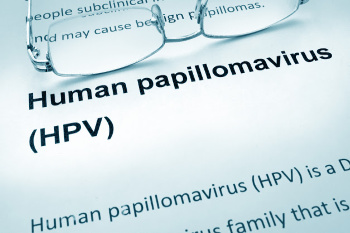
What is HPV? How is it transmitted?

HPV stands for human papillomavirus, a term that refers to over 150 types of viruses. Some types of HPV cause genital warts and other types can cause cancer, including anal, penile, cervical, vaginal, and vulvar cancers. Oral cancers can be caused by HPV infection, too.
HPV is the most common sexually transmitted infection, and most of the time, it clears up on its own. However, since certain types can cause serious illnesses, it’s important to understand how it is spread and how to reduce your risk.
Often, people aren’t aware they have an HPV infection because they do not have symptoms. Or, they might develop symptoms years after they become infected.
Most HPV infections are spread through skin-to-skin contact. The virus enters the body through a cut or abrasion on the skin. This can happen during anal and vaginal sex and through sexual touching. HPV can also linger on sex toys, even after they have been cleaned.
HPV can be transmitted during oral sex as well. Infections that cause HPV-related cancers in the throat, pharynx, soft palate, tonsils, and tongue are often spread this way.
It is unclear to what extent HPV is transmitted through deep kissing, but the risk is thought to be low.
To reduce your risk for HPV infection, consider the following precautions:
- Get vaccinated. The best time to get the HPV vaccine is between the ages of 10 and 12, before a person becomes sexually active; however, girls, boys, men, and women can be vaccinated as adults, too. In the United States, the Gardasil 9 vaccine is approved for people aged 9 to 45. (Gardasil 9 covers nine types of HPV viruses.)
- Women – Have regular pap smears, even if you’ve been vaccinated against HPV. If either partner has a known HPV infection (or any sexually transmitted infection), do not have sex until the infection has cleared.
- Do not have sex if you or your partner has genital warts. Have the warts treated as soon as possible.
- Know your partner’s sexual health history, including number of partners and past experiences with sexually transmitted infections.
- Use condoms and dental dams during every sexual encounter. (A dental dam is a small piece of plastic that covers the genitals during oral sex.)
- Limit your number of sexual partners. Risk for HPV infection increases with the number of partners you have. If your partner has had multiple sex partners, that increases your risk, too.
Resources
- Centers for Disease Control and Prevention
“Human Papillomavirus (HPV)”
(Page last reviewed: December 13, 2016)
https://www.cdc.gov/hpv/parents/whatishpv.html - Cleveland Clinic
“HPV (Human Papilloma Virus): Prevention”
(Last reviewed: September 18, 2018)
https://my.clevelandclinic.org/health/diseases/11901-hpv-human-papilloma-virus/prevention - Current Oncology
Touyz, L.Z.G., BDS MSc (Dent) MDent (PerioandOralMed)
“Kissing and HPV: honest popular visions, the human papilloma virus, and cancers”
(June 2014)
https://www.ncbi.nlm.nih.gov/pmc/articles/PMC4059815/ - Harvard Health Blog – Harvard Medical School
LeWine, Howard, MD
“HPV transmission during oral sex a growing cause of mouth and throat cancer”
(Updated: November 29, 2016)
https://www.health.harvard.edu/blog/hpv-transmission-during-oral-sex-a-growing-cause-of-mouth-and-throat-cancer-201306046346 - HealthDay via WebMD
Thompson, Dennis
“HPV-Linked Oral Cancers May Not Be ‘Contagious’”
(April 29, 2014)
https://www.webmd.com/sexual-conditions/hpv-genital-warts/news/20140429/hpv-linked-oral-cancers-may-not-be-contagious#1 - International Society for Sexual Medicine
“Is oral sex related to certain types of cancers?”
https://www.issm.info/sexual-health-qa/is-oral-sex-related-to-certain-types-of-cancers/?ref_condition=sti-std - Inverse.com
Betuel, Emma
“Sexual Health Experts Address a Common Fear About HPV and Kissing”
(January 12, 2019)
https://www.inverse.com/article/52385-can-you-get-hpv-from-kissing-experts - Mayo Clinic
“HPV infection”
(October 19, 2018)
https://www.mayoclinic.org/diseases-conditions/hpv-infection/symptoms-causes/syc-20351596 - Medical Daily
Bachai, Sabrina
“Sex Toys Can Show Traces Of HPV 24 Hours After Use, Have Increased Chance Of Spreading Virus, Despite Cleaning”
(April 23, 2014)
https://www.medicaldaily.com/sex-toys-can-show-traces-hpv-24-hours-after-use-have-increased-chance-spreading-virus-despite-278526 - SexHealthMatters.org
“FDA Approves HPV Vaccine For Adults”
(November 26, 2018)
https://www.sexhealthmatters.org/news/fda-approves-hpv-vaccine-for-adults



